Infection & response topic 3 biology
1/37
Earn XP
Description and Tags
Name | Mastery | Learn | Test | Matching | Spaced |
|---|
No study sessions yet.
38 Terms
What are pathogens, what do they cause, what can they infect?
Pathogens are microorganisms that enter body & cause disease
Cause communicable (infectious) diseases , can be easily spread
both plants & animals can be infected by pathogens
Describe bacterial cells? How do they make you feel ill?
Really small cells (1/100 size of body cells) can reproduce rapidly inside body
Make you feel ill → producing toxins (poisons) that damage cells & tissues
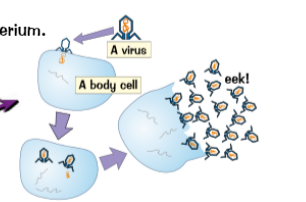
Why are viruses not cells? Where can they reproduce? They live inside? What can they do to cells?
Aren’t cells → tiny about 1/100 size of bacterium
Can reproduce rapidly inside body
live inside cells & replicate using cells’ machinery to produce copies of themselves, cell usually bursts releasing all new viruses
cell damage make you feel ill
What are protists (description)? What do they do?
all eukaryotes & most are unicellular
Some are protists, live on/ inside organisms & cause damage. Often transferred to organism by vector (doesn’t get disease itself - insect carries protist)
Some fungi are? What do Hyphae do? What do they produce?
some are unicellular, others have body made up of hyphae (thread-like structures)
Hyphae grow & penetrate human skin & surface of plants causing disease
Hyphae produce spores → spread to other plants & animals
How can pathogens be spread? (3 points & examples)
Water → by drinking/ bathing in dirty water → bacterial infection, by drinking water contaminated with diarrhoea of other suffers
Air → carried in air & breathed in → airborne pathogens carried in air in droplets (produced when cough/sneeze) → influenza virus causes flu spread this way
Direct contact →touching contaminated surfaces including skin → athlete’s foot makes skin itch & flake off, spread touching same things as infected person (shower floors, towels)
Hows measels spread? you develop? It can be/lead to? How are we protected from it?
spread by droplets from infected persons sneeze/ cough,
Develop red skin rash & show signs of fever
Can be serious/ fatal, if complications. Can lead to pneumonia/ inflammation of brain (encephalitis)
Most are vaccinated against it when young
How is HIV spread? What does it cause? What does the virus do? How does the immune system react?
spread by sexual contact/ exchanging bodily fluids (blood), can happen when sharing needles when taking drugs
Causes flu-like symptoms for weeks, usually don’t experience symptoms for years → HIV can be controlled with antiretroviral drugs, stop virus replicating
Virus attacks immune cells
Body’s immune system badly damaged → cant cope with other infections/ cancers → virus known as late stage HIV infection/ AIDS
What does tobacco mosaic virus affect? What does it cause? And that means?
affects many species plants (tomatoes)
causes mosaic pattern on leaves of plants → become discoloured
Discolouration means plants cant carry out photosynthesis as well→ affects growth
Whats Rose black spot (fungal disease)? Whats an effect of this? How does it spread? How is it treated?
Rose black spot (fungus) → causes purple/ black spots develop on leaves of rose plants → leaves turn yellow & drop off
Less photosynthesis → plant doesn’t grow very well
Spreads through environment (water/ wind)
Treat using fungicides & stripping plant of affected leaves → need to be destroyed so fungus cant spread
Whats malaria? How is it spread? It causes? How do you reduce the spread? How can you be protected from it?
Malaria → protist’s life cycle take place inside mosquito (vectors), pick up malaria protist when feed on infected animal
Every time mosquito feeds on other animal → infects by inserting protist into blood vessels
Cause repeating episodes of fever, can be fatal
Reduce spread → stopping mosquitos from breeding
Protected from mosquitoes using insecticides & mosquito nets
What does Salmonella cause? Symptoms? What are symptoms caused by? How do you get salmonella? In the UK?
causes food poisoning
suffer from fever, stomach cramps, vomiting & diarrhoea
symptoms caused by toxins bacteria produce
get salmonella by eating food contaminated with salmonella bacteria (eating chicken caught disease whilst alive/ eating food contaminated by being prepared unhygienic way)
In UK most poultry (chicken & Turkeys) given vaccination against salmonella → controls spread of disease
What are STDs transmitted through? Whats gonorrhoea caused by? Symptoms? What was it originally treated with? How to prevent the spread of gonorrhoea?
STD’s transmitted sexual contact (unprotected sex)
caused by bacteria
symptoms → pai when urinating, thick yellow/ green discharge from vagina/ penis
originally treated with penicillin (antibiotic), strains of bacteria became resistant to it
Prevent spread of gonorrhoea → treated with antibiotics & use barrier methods of contraception
How can spread of disease be reduced/ prevented (4 points)
Hygienic → simple hygiene measures → washing hands before preparing food/ after sneezed
Destroying vectors → insects can be killed using insecticides/ by destroying habitat (no longer breed)
Isolating infected individuals → isolate someone with communicable disease → prevent passing it on
Vaccination (communicable disease)→ less likely develop infection & pass it on
5 ways the body defends itself to stop bacteria/ pathogens getting in
skin (barrier) to pathogens & secretes antimicrobial substances (kill pathogens)
hair & mucus in nose trap particles that could contain pathogens
trachea & bronchi (breathing pipework) secrete mucus to trap pathogens.
Lined with cilia (hair-like structures) waft mucus up back of throat where can be swallowed
Stomach produces hydrochloric acid (kills pathogens make it far from mouth)
Give 2 ways the immune system stops pathogens?
pathogens make it into body → immune system destroy them
Most important part of immune system → white blood cells → travel around blood & crawl into every part body, constantly patrolling for microbes → come across invading microbes have 3 lines of attack
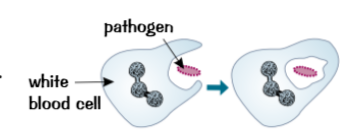
3 lines of attack when white blood cells come across invading microbes
phagocytosis → engulf foreign cells & digest them
Producing antibodies → invading pathogens have antigens on surface → WBC find & produce proteins (antibodies - specific antigens) lock onto invading cells (find & destroy),antibodies produced rapidly & carried in blood to find similar bacteria & viruses, remember pathogen (rapidly produce antibodies to kill → immune to pathogen)
Producing antitoxins → counteract toxins produced by invading bacteria

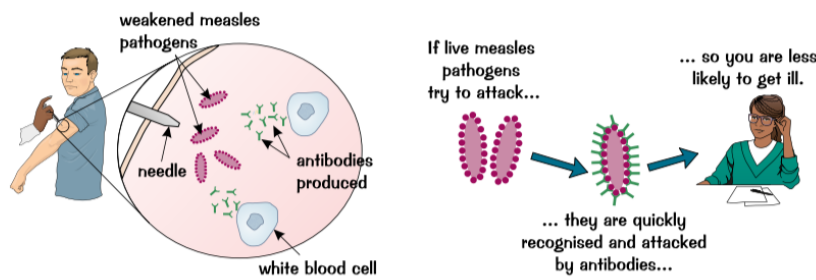
Infection with a new pathogen? What do vaccinations involve & whats does the MMR vaccine contain? What happens if the same type of pathogens appear after?
infected with new pathogen, takes white blood cells time to learn how deal with it (by that time can get ill)
Vaccinations usually involve injecting small amounts of dead/ inactive pathogens → carry antigens which cause body to produce antibodies (attack them) → even though pathogen is harmless (dead/inactive) → example, MMR vaccine contains weakened versions virus that causes measles, mumps. rubella (German measles) in one vaccine
If pathogens of same type appear after → white blood cells rapidly mass-produce antibodies to kill pathogen
Pros of vaccination (2 points, example, outbreak)
helped control lots communicable diseases, were once common (polio, measles, whooping cough, mumps, rubella, tetanus) → small pox doesn’t occurs at all & polio infections fallen by 99%
epidemics (big outbreak of disease) prevented if large percentage population is vaccinated → people who aren’t vaccinated unlikely catch disease (fewer people able pass it on). Significant number people who aren’t vaccinated → disease can spread quickly through them & lots peope ill at same time
Cons of vaccination
don’t always work → don’t give immunity
Can have bad reaction to vaccine (swelling or something more serious like fever/ seizures), but are very rare
What 2 drugs/ treatments relieve symptoms? What 3 drugs/ treatments cure the problem?
Relieve symptoms
painkillers (aspirin) relieve pain, don’t tackle cause of disease/ kill pathogens, help reduce symptoms
Lots cold remedies don’t actually cure colds
Cure problem
antibiotics (penicillin actually kill/ prevent growth of bacteria causing problem without killing own body cells, different antibiotics kill different types of bacteria → important treated with right one
Antibiotics don’t destroy virus (flu/ cord viruses), viruses reproduce using body cells → very difficult to develop drugs that destroy just virus without killing body cells
Use of antibiotics greatly reduced number deaths from communicable diseases caused by bacteria
How do bacteria become resistant? In an infection some? What happens when you treat the infection? How does the population increase? The resistant strains can cause? How do you slow down the rate of development of these strains? Whats important?
bacteria mutate (sometimes cause them to be resistant/ not killed by antibiotic)
Infection → some bacteria antibiotic resistant
Treat infection→ only non-resistant strains bacteria killed
individual resistant survive & reproduce → population increases (natural selection)
restrain strain cause serious infection , MRSA (meticillin-resistant-staphylococcus aureus) causes serious wound infections & resistant to powerful antibiotic meticillin
Slow down rate development resistant trains → doctors avoid over-prescribing antibiotics (wont get them for sore throat, only something serious)
Important Finish whole course antibiotics & don’t stop once feel better
What do plants produce? What are used as drugs? 2 examples?
plants produce variety chemicals to defend themselves against pests & pathogens
some chemicals used as drugs to treat human disease/ relieve symptoms. Current medicine discovered by studying plants used traditional cures:
Aspirin (painkiller & lowers fever, developed from chemical found in willow)
Digitalis (treat heart conditions, developed chemical found in foxgloves)
What did Fleming notice? What did he find? How are drugs produced in these days?
Alexander Fleming clearing out petri dishes containing bacteria, noticed one had mould on it & area around mould was bacteria free
Found mould (penicillium notatum) on petri dish was producing substance that killed bacteria → penicillin)
(these days drugs made large scale in pharmaceutical industry - produced by chemists in lab , process might start with chemical extracted from plant)
3 main stages in drug testing
Preclinical testing, → human cells & tissues,
Preclinical testing → living animals test (efficacy, toxicity, dosage)
Clinical trials → human volunteers, healthy volunteers → sufferers of disease
Preclinical testing (1 drug testing) (can’t, example)
tested on human cells & tissues in lab,
cant use human cells & tissues to test drugs affect whole/ multiple body systems (testing drug for blood pressure must be done on whole animal because has intact circulatory system)
describe the process of preclinical testing (drug testing 2)
test drug on live animals, to test for efficacy (whether works & produces effect looking for), toxicity (how harmful) & best dosage (concentration should be given & how often)
Law in britain → any new drug must be tested on 2 different live mammals → some think cruel test on animals but others think safest way make sure drug isn’t dangerous
Describe the process of clinical trials
tested on healthy volunteers, make sure no harmful side effects when body working normally. Start trial = very low dose & gradually increased
tested on people suffering from illness, optimum dose found (most effective & few side effects)
test how well works → patients randomly put 2 groups, 1 given new drug & other placebo. Doctor can see actual difference drug makes → allows place effect
Are blind → patient doesn’t know whether getting placebo/ drug, often double blind → neither patient nor doctor know until results gathered. Doctor monitoring patients & analysing results aren’t subconsciously influenced
Results aren’t published until they’ve been through peer review → helps prevent false claims
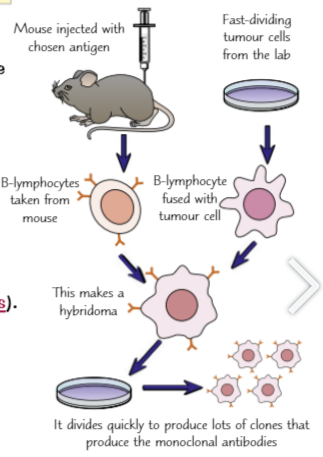
What are antibodies produced by? What do monoclonal antibodies do? What doesnt divide easily? Tumour cells dont? Whats a hybridoma cell? What do they do? How can you make monoclonal antibodies bind to anything?
antibodies → produced B-lymphocytes (type white blood cell)
Monoclonal antibodies → produced lots clones of single white blood cell → all antibodies identical & will target 1 specific protein antigen
Lymphocytes don’t divide easily
Tumour cells → don’t produce antibodies but divide lots → grown really easily
Possible fuse mouse B-lymphocyte with tomour cell → hybridoma cell
Hybridoma cells → cloned to get lots identical cells → produce same antibodies (monoclonal) → can be collected & purified
Can make monoclonal antibodies bind to anything → antigen only found on surface of 1 type cell → MA really useful because only bind to (target) that molecule → use target specific cell/ chemical in body

How are Monoclonal antibodies used in pregnancy test (HCG, pee, antibodies, pregnant, not)
Hormone HCG found in urine of pregnant women, pregnancy testing sticks detect HCG (hormone):
bit of stick pee on has some antibodies to hormone, with blue beads attached
Test strip (turns blue if pregnant) has some more antibodies to hormone stuck onto it (cant move)
If pregnant & wee on stick → hormone bins to antibodies on blue beads → urine moves up stick carrying hormone & beads → beads & hormone bind to antibodies on strip → blue beads get stuck on strip turning it blue
If not pregnant & wee on stick → urine moves up stick carrying blue beads →but nothing to stick blue beads onto test strip → doesn’t go blue
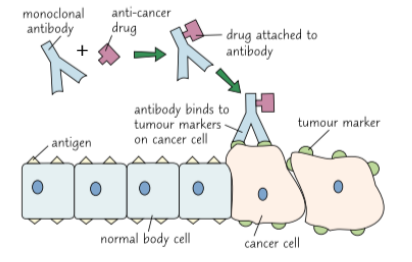
What do different cells have? What do cancer cells have on the cell membrane? What does a anti-cancer drug do? Antibodies given to the patient through a drip target? What does the drug kill?
different cells = different antigens on cell surface, make monoclonal antibodies bind to specific cells (just liver cells)
Cancer cells → have antigens on cell membrane that aren’t found normal body cells → tumour markers
Anti-cancer drug → attached to those monoclonal antibodies → might be radioactive substance, toxic drug/ chemical which stops cancer cells growing & dividing
Antibodies given to patient through drip → target specific cells (cancer cells), only bind to tumour markers
drug kills cancer cells but doesn’t kill normal body cells near tumour
What do monoclonal antibodies bind to? What do you test for? How do you locate specific molecules?
bind to hormones & other chemicals in blood to measure their levels
test blood samples in labs for certain pathogens
Locate specific molecules on cell or in tissue:
Monoclonal antibodies made that bind to specific molecule looking for
antibodies bound to fluorescent dye
if molecules present in sample → monoclonal antibodies attach to them & can be detected using dye
What do cancer treatments & monoclonal antibodies do? What are the side effects of monoclonal antibodies? Not as.. scientists originally thought?
other cancer treatments (standard chemotherapy & radiotherapy) can affect normal body cells whilst killing cancer cells, whereas monoclonal antibodies target specific cells → side effects of antiboy-based drug lower than chemotherapy/ radiotherapy
Monoclonal antibodies cause more side effects than originally expected → cause fever, vomiting, low blood pressure → when first developed scientists though because target specific cell/ molecule would create lots side effects
Not as widely used as treatments as scientists had originally thought
A lack of what causes stunted growth? What causes chlorosis & yellow leaves?
nitrates needed to make protein & therefore growth → lack causes stunted growth
Magnesium ions needed making chlorophyll which needed for photosynthesis → lack causes plants suffer from chlorosis & have yellow leaves
Common symptoms of disease? how to spot infestations of pests? How to identify different plant diseases?
common symptoms of disease → stunted growth, spots on leaves, patches of decay (rot), abnormal growths (lumps), malformed stems/ leaves, discolouration
Infestations of pests easy to spot → able to see them on plants
Different plant diseases have different signs, identified by:
1. looking up signs in gardening manual/ gardening websitetaking infected plant to lab, scientists can identify pathogen
using testing kits that identify pathogen using monoclonal antibodies
Physical defences of plants (barrier, physical, bark)
leaves & stems have waxy cuticle → provides barrier to stop pathogens entering
Plant cells surrounded by cell wall made of cellulose → form physical barrier against pathogens that make it past waxy cuticle
Layers of dead cells around stems → example, outer part of bark on trees → acts as barrier to stop pathogens entering
2 Chemical defences of plants
some produce antibacterial chemical which kill bacteria → mint plant & witch hazel
Others produce poisons which deter herbivores → tobacco plants, foxgloves, deadly nightshade
3 Mechanical defences of plants
thorns & hairs → stop animals touching & eating them
Leaves that droop/curl when something touches them → prevent themselves being eaten by knocking insects off themselves & moving away from things
Mimic other organisms → passion flower has bright yellow spots on leaves which look like butterfly eggs → stops other butterflies laying eggs there. Several species of plant in ‘ice plant family’ in southern Africa look likes tones & pebbles → tricks other organisms into not eating them